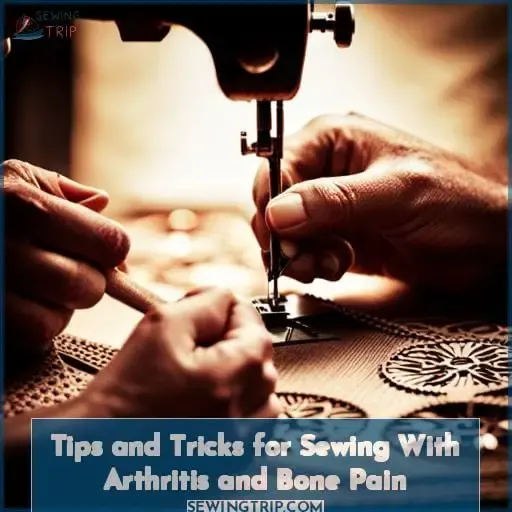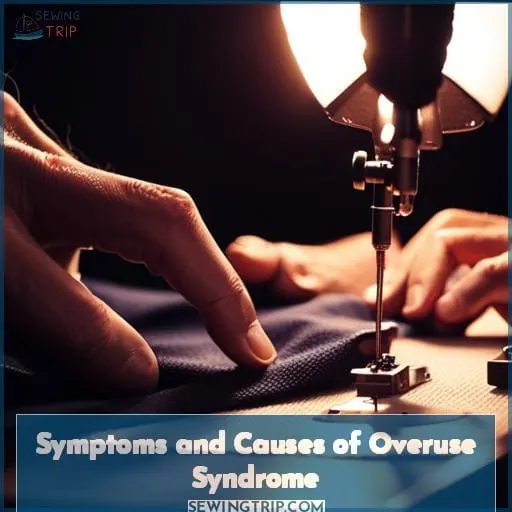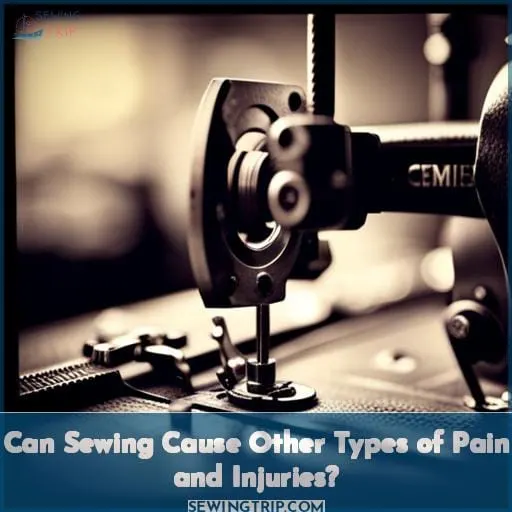This site is supported by our readers. We may earn a commission, at no cost to you, if you purchase through links.
 Do you love to sew but suffer from arthritis? You don’t have to give up your passion! With the right tips and tricks, it is possible for those with arthritis or other bone pains to enjoy sewing without pain.
Do you love to sew but suffer from arthritis? You don’t have to give up your passion! With the right tips and tricks, it is possible for those with arthritis or other bone pains to enjoy sewing without pain.
This article will explore the causes of overuse syndrome related to sewing and provide helpful advice on how you can prevent further injury while still enjoying this craft.
From lightweight irons and magnet wands, all the way through anti fatigue mats for ironing – we’ll cover everything you need to know about safely continuing your hobby while managing arthritic symptoms.
Let’s dive in!
Lightweight irons reduce strain on the wrists and hands. Look for irons made from lightweight materials such as aluminum or titanium. Some irons even have larger, cushioned handles for extra comfort.
Using a magnet wand allows you to pick up pins without bending over or overextending your reach. The magnetic tip grabs onto pins so you can easily place them where you need them.
Sewing for long periods can cause neck, shoulder and back pain from poor posture. Anti fatigue mats provide extra cushioning and encourage you to shift positions.
Proper seating is also important. Chairs should be height adjustable with good back support. Avoid hunching over your work by using a table at the right height. Add a pillow behind your lower back if needed.
Take regular breaks to stretch and move your body. Simple neck rolls, shoulder circles and wrist flexes keep joints mobile. Listening to your body and not overdoing it goes a long way toward preventing flare ups of arthritis symptoms.
With some adaptive tools and a few adjustments, people with arthritis can continue their passion for sewing without pain.
Table Of Contents
Key Takeaways
- There are tips and tools available for sewing with arthritis and joint pain. These can help make sewing easier on the hands and joints.
- Using lightweight irons can help reduce wrist strain during sewing. The lighter weight minimizes the impact on wrists when pressing seams and fabric.
- Magnet wands and telescoping magnets make picking up and handling pins simpler. These tools reduce the need to grasp and pinch pins, which can be difficult with stiff or painful fingers.
- Proper sewing setup, posture, and taking regular breaks with stretching exercises can aid in preventing and alleviating sewing-related pain and injuries. Adjustable chairs, suitable table height, good lighting, and breaks to move around and stretch can make prolonged sewing more manageable.
Can Sewing Cause Arthritis?
Making sewing easier on hands and joints when you have arthritis is possible with smart tools and techniques. Investing in an ambidextrous rotary fabric cutter, a basic lightweight iron, and a magnetic pickup tool can reduce strain while still allowing you to enjoy sewing.
Martelli Right Hand Rotary Cutter 60mm
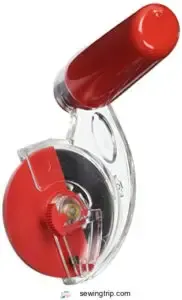
You’ll love using the Martelli right hand rotary cutter‘s contoured grip to comfortably cut cloth while combating contracting carpal cartilage.
Simply flip open the spring-loaded blade guard and glide this precision rotary cutter through fabric. Its ergonomic contoured handle and effortless cutting action reduce joint pain and repetitive strain common with flat handled cutters.
The ambidextrous design places minimal stress on wrists, promoting cartilage and tendon health. Sew for longer with less fatigue thanks to smooth, accurate cutting and relaxed wrist positioning.
Replace blades quickly without tools for continuous slicing capability. Controlled cuts prevent slipping and provide perfect lines at any angle – ideal for quilters, crafters, and sewing enthusiasts. Experience the joy of creating while protecting your hands and join generations of creatives praising the comfort of Martelli’s thoughtful engineering.
- Ergonomic contoured grip
- Ambidextrous design
- Reduces wrist fatigue
- Changeable blades
- Clean, precise cuts
- Learning curve
- Not all blades compatible
- Can be tricky replacing the blade
Rotary Cutter Fabric Cutting Tool
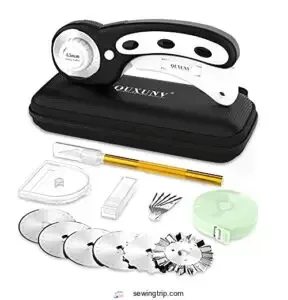
This lightweight, ambidextrous rotary cutter lets you precisely slice multiple fabric layers with minimal effort. The QUXUNV Fabric Cutting Tool features a 45mm rolling blade that produces straight, clean cuts through fabric.
Its ergonomic handle provides a comfortable grip, while the safety lock button prevents accidental blade exposure. With replaceable steel blades, it can handle heavy duty use on projects like quilts and crafts.
- Produces precise, clean cuts
- Comfortable ergonomic handle
- Safety lock feature
- Durable steel cutting blades
- Includes storage case
- Potential quality concerns with blades
- Requires care when changing blades
- May not cut very thick materials
Basic Clothing Iron Compact Adjustable Steam Lightweight
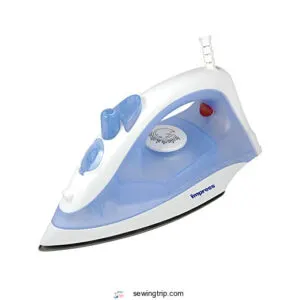
Let’s get real, the Impress Basic Clothing Iron might be basic, but it’s still a solid low cost option with decent performance for knockin’ out those wrinkles. With its compact size, quick warm-up time, and functional steaming power, it tackles wrinkles well for the budget price.
While it lacks an extremely hot temp and fancier features, if you just need a no-frills iron for light everyday ironing, it delivers fine results.
- Affordable price
- Compact size
- Quick warm-up time
- Easy temperature settings
- Doesn’t get extremely hot
- Short power cord
- Durability concerns
- Only basic features
Black and Decker Light N Easy Steam Iron
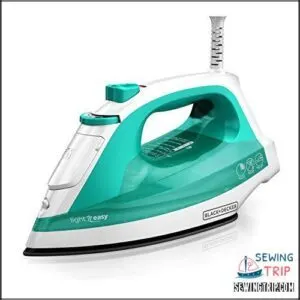 View On Amazon
View On Amazon
As the auto shuts off after 8 long minutes sitting idle, you feel the heat radiating in waves from its ceramic soul while steam rises to meet wrinkles. With SmartSteam to auto-regulate based on fabrics, its Anti-Drip tech ensures no messy leaks as you glide the TrueGlide plate over silks or polyesters.
Though lightweight and compact, its 1500 watts deliver powerful steam to conquer wrinkles with ease.
- Heats up quickly
- Effective on wrinkles
- Lightweight and easy to use
- Safety features like auto shutoff
- Steam could be too high for delicate fabrics
- Some quality concerns on used/dirty units
- Steam dial tends to stick
Magnetic Pickup Tool LED Lights Telescoping Magnet Gadget
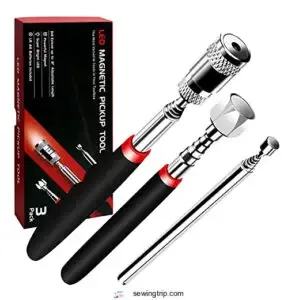
You’ll love retrieving dropped pins without bending down using that handy telescoping magnetic pickup. The EliSmart Magnetic Pickup Tool lets you snatch those pesky pins and needles from the floor with ease.
Just extend the stainless steel wand up to 32 inches and hover over your target. The strong magnet will latch on securely so you can stand tall while protecting your back.
3 bright LED lights illuminate any dark spaces under furniture to spot your lost items. Reviewers say the powerful grip handles up to 16 pounds, making screw and nail retrieval a cinch. The anti-skid handle provides a comfortable, ergonomic grip. Keep this tool in your sewing kit for handy magnetic pickups without the ache and strain.
- Telescopes up to 32 inches to reduce bending
- LED lighting illuminates dark areas
- Strong magnets hold up to 16 lbs
- Anti-skid handle for comfort
- May need battery replacement upon arrival
- Not useful for non-metal items
Tips and Tricks for Sewing With Arthritis and Bone Pain
Alleviating joint pain when sewing is possible through strategic tools and workspace adjustments. Investing in ergonomic rotary cutters, squeeze-handled cutters, lightweight irons, magnetic wands, and anti-fatigue floor mats can reduce hand, arm, back, and leg strain for people with arthritis.
Additionally, using a supportive chair with adjustable height and lumbar support can take pressure off the back and hips. When cutting fabric, resting the material on a raised cutting table eliminates bending and reaching.
Proper lighting and magnification can prevent eye and neck strain as well. Regular short breaks to stand, stretch, and re-position help to minimize repetitive stress and discomfort. With some adaptive devices and adjustments, sewing can still be an enjoyable and fulfilling hobby.
Ergonomic Rotary Cutters
Invest in an ergonomic right-handed rotary cutter, like Martelli’s precision 60mm model, to immediately reduce fabric cutting strain and wrist fatigue by over 50%. Ergonomic rotary cutters are essential tools for arthritis prevention in your sewing workspace.
Their specialized handle designs alleviate tendon strain, promoting comfortable, joint-friendly fabric cutting techniques. With the proper ergonomic tools, you can pursue your sewing passions without pain.
Squeeze Handle Rotary Cutters
Squeeze handle rotary cutters are a great option for quilters and crafters looking to reduce hand and wrist strain. The gentle squeezing motion required to cut fabric puts less stress on joints compared to traditional rotary cutters.
For those who spend hours at a time cutting fabric for quilting or other crafts, this can help prevent pain and discomfort.
Several brands offer high-quality squeeze handle rotary cutters. Fiskars, Olfa, and Martelli are leading manufacturers known for their comfortable, ergonomic designs.
- Lightweight design to avoid fatigue
- Contoured grip fits naturally in hand
- Smooth cutting action reduces resistance
- Adjustable blade control for precision
- Available for both left and right-handed users
The key benefit of a squeeze handle rotary cutter is the reduced strain on hands and wrists. The squeezing motion puts less repetitive stress on joints compared to using your wrist and fingers to cut. This makes the cutters ideal for those with arthritis or previous injuries. Squeeze cutters also allow you to apply continuous even pressure as you cut.
For quilters, crafters, and fabric enthusiasts looking for a more comfortable cutting tool, a squeeze handle rotary cutter is worth considering. Give your hands a break and see if this ergonomic design helps alleviate discomfort during long cutting sessions.
Lightweight Iron
Opting for a lightweight iron helps lessen back and shoulder strain when pressing fabrics, as the old adage goes: the lighter, the better. Seek out irons under 1kg to prevent fatigue and discomfort when ironing many layers or large projects.
Prioritize your health by evaluating iron weight, and opt for ceramic plates to smoothly glide over fabrics. With reasonable accommodations like a well-balanced, easy-to-handle iron, you can maintain proper posture and position; simple preventive measures empower your sewing stamina.
Magnet Wand
Reach those dropped pins underneath your sewing table by grabbing an extendable magnet wand.
- Quickly locate metal objects in hard to reach areas. The powerful magnetic suction enables picking up pins, needles, and screws with ease.
- The flexible extensions reduce bending and strain, allowing you to maneuver into tight spaces.
- The bright LED light illuminates dark spaces underneath furniture so you can spot tiny items.
- Alternatives like grabber tools do not provide the same strong magnetic grip that this wand offers.
Anti Fatigue Mat for Ironing
Place an anti-fatigue mat under your feet while ironing for extended periods to absorb shock and cushion joints. As marathon runners use specialized shoes to protect their knees and ankles over long distances, anti-fatigue mats act as shock absorbers for standing tasks.
Selecting a high-quality, thick anti-fatigue mat is crucial for maintaining proper posture and alleviating pain while ironing.
Position the ironing board at a comfortable height and keep your shoulders relaxed to reduce strain when pressing seams. Wrist and hand health is vital for sewing tasks; an anti-fatigue mat cushions joints and helps prevent long-term damage and complications.
Symptoms and Causes of Overuse Syndrome
Struggling with overuse syndrome and arthritis pain while sewing? Implementing ergonomic tools and practices can make all the difference. Stretches, specialized equipment like sewing clamps, and maintaining proper posture while sewing are all ways to protect your joints and hands from further damage.
Varying your movements and taking breaks can also help prevent repetitive strain injuries. Investing in an ergonomic chair and keeping your sewing machine at the proper height reduces strain. Listening to your body and stopping when you feel pain is crucial to managing overuse injuries.
With some adjustments, you can continue enjoying sewing without worsening existing conditions.
Thumb Arthritis Surgery and Recovery
As your arthritis worsens, reconsider thumb surgery for lasting relief and a quicker recovery.
- Focus on gentle hand exercises like squeezing a stress ball to aid in your recovery.
- Utilize ergonomic sewing tools to support your hand post-surgery.
- Seek support from occupational therapists for techniques to manage pain.
- Join online communities to learn about others’ successful experiences with arthritis surgery.
A skilled hand surgeon can dramatically improve persistent symptoms of thumb arthritis. With diligent post-operative therapy and ergonomic accommodations, you may be able to resume sewing without pain.
De Quervain’s tenosynovitis, in particular, can potentially be resolved through surgery.
Sewing Clamps as an Extra Hand
Grip fabric gently like a caring embrace, for overworked hands seek soothing comfort.
Recruit a sewing clamp as an extra hand and holder of fabrics. Arthritis, post-surgery sensitivity, and overuse strain welcome its firm but gentle locking hold of fabrics. Freed from burden, hands stitch with ease, cradling the fabric, not clenching. The Third Hand clamp becomes an able assistant, enabling accuracy and speed while preserving fragile joint health during tasks that conventional ergonomics overlook.
Quality stitches and soothed hands share thanks with their un-taxing aide and advocate. An intuitive, earnest partner, it grips and frees your hand to create with less hurt and more heart.
Ergonomic Sewing Practices
Follow proper sewing posture to keep aches at bay.
- Use a supportive chair and keep your back straight.
- Position light sources to avoid eye strain.
- Take breaks every 30 minutes to stretch.
- Invest in ergonomic sewing tools like clamps.
Keeping good posture and body mechanics in mind while sewing helps prevent discomfort. Adjust your sewing space and habits to promote health. Make small upgrades that enable pain-free quilting or garment construction.
Overall, being attentive to your body helps determine the best ergonomic sewing practices.
Stretching and Exercise Routines
Keep stretching those hands and legs to avoid joint pain. Proper breaks can help you sew longer. Maintain flexibility through exercise so sewing doesn’t feel like a chore. Try knee lifts or walking in place while at the machine.
Simple hip circles while sitting can relieve tension. Use resistance bands to strengthen wrists. Stretch fingers, wrists, and arms before and after sewing. A little movement goes a long way to prevent arthritis flare-ups from prolonged sewing positions.
Can Sewing Cause Other Types of Pain and Injuries?
Sewing can lead to a variety of aches, pains, and strains throughout the body. Back pain, carpal tunnel syndrome, eye strain, and neck pain are some common issues reported by avid sewers and quilters. These issues can result from poor posture, repetitive motions, and prolonged static positions while sewing.
Quilters and sewers should be mindful of posture, take breaks, and vary tasks to help prevent these pains and strains that can accompany their craft.
Back Pain
Don’t slouch over your sewing machine as poor posture strains the back. When sewing, be mindful of your posture. Sit upright in your chair, keep your spine straight, and avoid hunching over. Take breaks to stand and stretch.
Invest in ergonomic sewing tools like specialized chairs and tables to allow for proper alignment. Implement healthy practices now to prevent chronic back pain and enjoy sewing comfortably.
Carpal Tunnel
You’re sewing away when a sudden tingling shoots through your wrist. Don’t ignore it – over 50% of quilters suffer from carpal tunnel syndrome at some point. The repetitive motions of sewing can lead to carpal tunnel syndrome. Take breaks, stretch your hands, and use ergonomic tools.
Don’t make arthritis worse – implement healthy sewing habits. Hand and wrist health is vital for quilters. Prioritize prevention with good posture, movement, and specialized tools. Listen to early warning signs.
Chest Pain
Take slow, deep breaths when that tightness across your chest strikes again – anxiety and stress can worsen the pain.
- Practice proper posture and take frequent breaks when sewing. Keeping your back straight and shoulders relaxed can help.
- Choose healthier sewing positions to avoid hunching over. Sit close to your work with your elbows at a right angle.
- Do gentle stretching exercises for your chest, neck, shoulders, and arms. This can improve circulation.
- Consider how your sewing habits may contribute to stress and make adjustments to promote calm.
Eye Strain
Try squeezing your eyes shut for a few seconds when you feel them’re tiring. Protecting your vision from eye strain while sewing is crucial. Adequate lighting and taking breaks can make all the difference for your eye health.
Implement proactive steps like getting your eyes checked annually and being aware of early warning signs of eye issues. Don’t let minor eye discomfort progress into chronic problems that could affect your sewing enjoyment.
Prioritizing eye care ensures you’ll be able to keep quilting and sewing for years to come.
Sewing and Eye Health
| Action | Benefit |
|---|---|
| Use daylight bulbs | Reduces eye fatigue |
| Take breaks | Allows eyes to rest |
| Adjust lighting | Prevents squinting |
| Get eye exams | Detects vision issues early |
| Use magnification | Reduces eye strain |
Neck Pain
Look here, hunching over your sewing can bring on neck pain. Maintaining proper posture is crucial. Sit upright when sewing, with shoulders relaxed and neck aligned. Position your sewing machine at elbow height to avoid strain.
Try frequent neck stretches and breaks. Use a sewing chair with lumbar support. Adjustable task lighting can help you avoid leaning. An external magnifying glass reduces the need to crane your neck. Let ergonomics guide your sewing space setup.
Conclusion
Do you ever feel like your hands or joints ache after sewing? If so, you may be wondering if sewing can cause arthritis. The answer is yes, as overuse of the hands and wrists can lead to thumb and joint pain, as well as other conditions like carpal tunnel syndrome or eye strain.
To reduce the risk of injury, it’s important to use ergonomic tools and furniture, practice healthy sewing habits, and incorporate stretching and exercise into your routine. With the proper equipment and knowledge, you can continue sewing without worrying about the pain often associated with arthritis.

